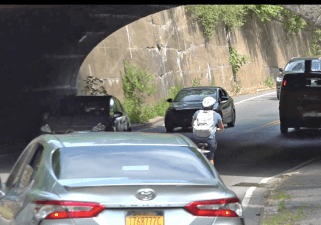Plans For First Two Crosstown Central Park Bike-Ped Paths Take Shape
Details are emerging about the plan to create shared bike/pedestrian paths cutting east-west across Central Park. The first two paths are likely to officially open on a trial basis in September, cutting across the park at roughly 102nd Street and 96th Street, said Central Park Conservancy community relations manager Caroline Greenleaf at a Community Board 7 meeting last night.

Those paths will be clearly marked with new signage and painted diamonds on the pavement, as on the park’s only current bike/ped path, which connects West 106th Street to the loop drive. The paths won’t be divided into separate lanes for those on foot and those on two wheels, said Greenleaf, but the diamonds will be off to one side of the path.
What those signs should say was a point of contention. Greenleaf said they are likely to urge cyclists to go at “walking speed,” but many members of the CB 7 Parks and Transportation Committees found that overly restrictive.
The co-chairs of the Parks Committee, Klari Neuwelt and Elizabeth Starkey, pointed out that they had sent a letter to the Parks Department months ago recommending that shared paths in Central and Riverside Parks use language like “yield to pedestrians” or “go slow,” rather than speed limits that did not leave room for discretion. “It was not intended to have cyclists go so slowly they fall off their bikes,” said Neuwelt.
At one point, the restrictions on the paths may be more stringent still. Where the 96th Street route, which will run just south of the transverse road on a little-used path, crosses the East Drive, said Greenleaf, a dismount zone is under consideration. “There are issues about whether it’s actually safe to cross the drives on your bicycle,” she said, adding that those issues were exacerbated at that crossing by a hairpin turn just east of the loop.
A number of community board members pointed out how much more smoothly these paths could be implemented if cars were taken off the Central Park loop drives altogether. “It sounds like a lot of this is the result of avoiding automobile traffic,” said board chair Mel Wymore. The community board endorsed a car-free park trial by a vote of 32-1 in June.
The two board members who spoke against the shared paths, though, also cited the board’s support for a car-free Central Park to make their case. “The request is not by park users,” said Tom Vitullo-Martin in an argument echoed by Transportation Committee co-chair Dan Zweig. “It’s for roads to be cut across the park for bicycles.”
Even so, the bulk of community board members and neighborhood residents in attendance spoke in support of trying out the plan. No vote was taken, as Wymore wanted the board to speak up on the plan after the trial was underway.
Wymore also urged the Conservancy to generate hard data on which to evaluate the plan. Greenleaf said that the Conservancy is currently planning to have staff and volunteers qualitatively observing the way the lanes are used and gathering feedback from park users.


